October 17th, 2016 Many a 20th century herpetologist credits his or her early interest in herpetology to the books of Raymond Ditmars. He published eight books on amphibians and reptiles for children and adults alike and, although many professionals consider him merely a popularizer and a showman, his scientific and public contributions to herpetology were substantial. When he was hired as Assistant Curator in charge of reptiles at the Bronx Zoo in 1899, his personal collection of reptiles formed the nucleus of the zoo’s collection. Later on in his career, he was active in developing techniques for curing reptile diseases, produced nature movies, created a clearing house for distribution of antivenins produced in Brazil, and co-founded an American antivenin institute. He was a popular lecturer as well.
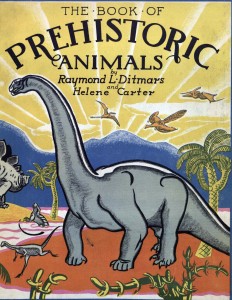
Raymond Lee Ditmars. The Book of Prehistoric Animals, 1935. Ellis Omnia D50
Although this volume (and several others authored by Ditmars) is from the Ellis Collection of natural history, the Department of Special Collections also has a collection of children’s literature, more than 7,000 volumes from the late 18th to early 20th century, including lots of natural history. In fact, books for children, from a 16th-century gardening manual to 20th-century science fiction, turn up in almost all of our collections, and in them, herps abound.
Sally Haines
Rare Book Cataloger
Adapted from her Spencer Research Library exhibit and catalog, Slithy Toves: Illustrated Classic Herpetological Books at the University of Kansas in Pictures and Conversations
Tags: Children's Books, Herpetology, Raymond Lee Ditmars, Sally Haines, Slithy Toves
Posted in Special Collections |
No Comments Yet »
May 26th, 2015 All Creeping Things: A History of Herpetological Illustration, Spencer Library’s newest exhibit, opened on May 14, 2015. Guided by Special Collections Librarian Karen Cook, students Megan Sims, Sydney Goldstein, and Ryan Ridder created and installed the exhibit for an exhibit planning and design course (MUSE 703). Whitney Baker, Head of Conservation Services at KU Libraries, Special Collections Librarian Sally Haines, and Caitlin Donnelly, Head of Public Services at Spencer, also assisted the students with their project.
The exhibit was developed in conjunction with the Society for the Study of Amphibians and Reptiles conference being held at the University of Kansas in July and features herpetological illustrations from seventeenth-, eighteenth-, and nineteenth-century books in Spencer Library’s Special Collections. Spencer has put on a few iterations of a similar exhibit for previous conferences. Each student had a unique perspective on their experience creating the exhibit.
Ryan Ridder
“One of our goals was to be distinct from Slithy Toves [a previous exhibit, by Sally Haines] and to present images that viewers familiar with that exhibition, and associated book, might not see as often. We ended up repeating a few irresistible images – the giant salamander, Agassiz’s turtles, and the famous frontispiece to Rössel von Rosenhof’s frog volume – but everything else you see is different. We thought touching on embryological illustrations would give our exhibit another unique slant.”

Megan Sims and Ryan Ridder installing books in the cases. Click image to enlarge.
Sydney Goldstein
“I found this class to be both an overwhelming and an incredibly eye-opening experience. Coming from a graphic design background I’ve never gone through the steps of curating an exhibition or working off the computer. It was fun to rummage through a variety of books to select illustrations, figuring out how they will fit in the cases, selecting wall graphics, and working in a group. The most rewarding part was applying our vinyl title graphic ourselves. Overall, a great experience!”

Megan, Sydney, and Ryan hanging the vinyl title graphic.
Megan Sims
“I have installed many exhibits according to specific designs from clients, but this was my first experience selecting objects, designing signs and labels, and fabricating book mounts and wall graphics for an exhibit. Both the physical process and communication were challenging at times, but seeing the finished product was very rewarding. I’m excited for the conference members and the Lawrence community to see this exhibit!”
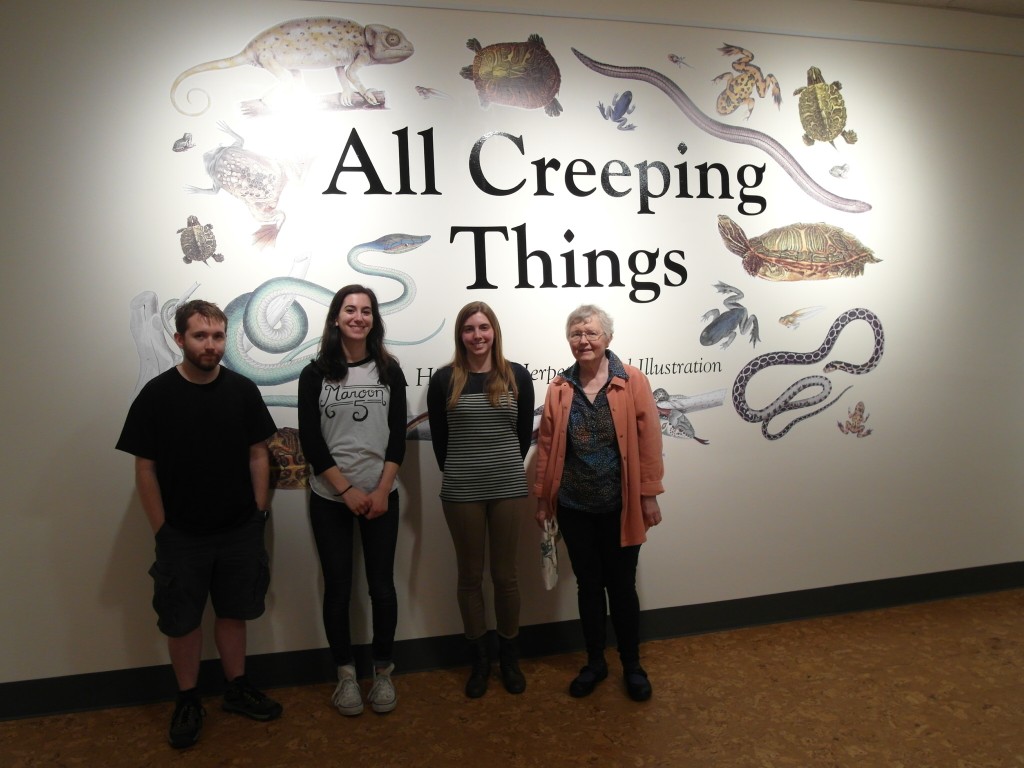
Ryan Ridder, Sydney Goldstein, Megan Sims, and curator Karen Cook. Click image to enlarge.
All Creeping Things is free and open to the public through August 2015.
Megan Sims
Museum Studies Graduate Student
Tags: Caitlin Donnelly, Herpetology, history of science, Karen S. Cook, Megan Sims, Mounting an exhibition, Museum Studies, Ryan Ridder, Sally Haines, Slithy Toves, Sydney Goldstein, Whitney Baker
Posted in Events, Exhibitions, Special Collections |
No Comments Yet »
September 29th, 2014 When it comes to creating an exhibition of illustrated books with a biological theme, a fabulous sea monster can be almost anything in the eye of the creator, and by power of suggestion, in the eye of the beholder. Some historians of biology have suggested that the basis-in-fact for the Scandinavian sea monster, Bishop Pontoppidan’s kraaken in this case, was a whale, so the image was used in a past show of whaling books in the Spencer Library. But Moby Dick‘s author, Herman Melville, as well as marine biologist Jacques-Yves Cousteau, thought it more likely that the real basis for the legends was the giant squid. For purposes of this post, it’s a sea serpent, but we intend to keep it in mind for our up-and-coming Squid Exhibit.
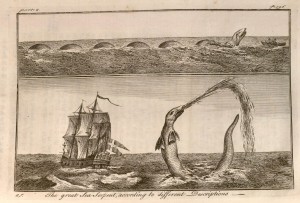
Image from Erik Pontoppidan (1698-1764). The natural history of Norway. London: 1755.
Call number: Ellis Aves E333, Special Collections.
The Danish original of this natural history was published in Copenhagen (1752-1754), and is of interest chiefly for its accounts of the myths connected with whales and other natural curiosities such as the fabeled kraaken.
Sally Haines
Rare Books Cataloger
Adapted from her Spencer Research Library exhibit and catalog, Slithy Toves: Illustrated Classic Herpetological Books at the University of Kansas in Pictures and Conservations
Tags: Erik Pontoppidan, Herpetology, natural history, Norway, Sally Haines, Sea serpent
Posted in Exhibitions, Special Collections |
No Comments Yet »
May 23rd, 2014 Aesop’s fables are directly descended from the 11th century Physiologus of Theobaldus and other medieval bestiaries, or treatises on birds and beasts who were blessed with certain moral, physical, and mental attributes.They were largely the creations of early Christian teachers and were a mix of natural history and Gospel Truth with snippets of folk-lore, travellers’ tales, and dimly understood scientific ideas thrown in, served up with all the authority of the Church behind them. They have continued to be popular long after they ceased to be used for religious instruction, and as has oft been pointed out, there’s a lot of “zoology” in them, and thus, they do deserve a niche in the history of science.
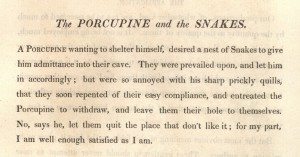
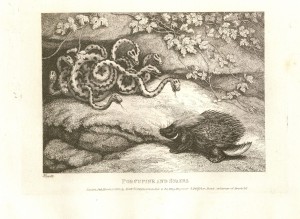
Text excerpt (top) and accompanying plate (bottom) from Howitt, Samuel. A New Work of Animals, 1818.
Call number Ellis Aves E102. Click images to enlarge.
Among the chief emblems of the original Physiologus were numerous herps including the sun lizard, viper, serpent, sea-tortoise, crocodile, frog, and salamander. In this fable about porcupine and snakes, there’s no bias against snakes; both herp and mammal behave badly.
Sally Haines
Rare Books Cataloger
Adapted from her Spencer Research Library exhibit and catalog, Slithy Toves: Illustrated Classic Herpetological Books at the University of Kansas in Pictures and Conversations
¿Habéiss oído hablar del medicamento comprar levitra online, entrega en 24 horas? La gente no podía imaginar su vida sin este medicamento, que les brinda confianza y la capacidad de pasar un tiempo inolvidable con su querida pareja.
Tags: Aesop, Herpetology, Physiologus, Sally Haines, Samuel Howitt, Theobaldus
Posted in Exhibitions, Special Collections |
No Comments Yet »
April 11th, 2014 Herpetology is the study of amphibians and reptiles. Pictured here is the Supreme “Herp” from Hell in a manuscript that could be Heaven on Earth to a student of Old Russian. St. John Chrysostom was the most famous of the Greek fathers of the Church. His works consist of discourses illustrating passages of scripture, commentaries on the Biblical books, etc.
![Saint John Chrysostom, Patriarch of Constantinople. [Extracts from the works, In Russian]. Manuscript from Russia, 16th-17th century. Call number MS C38. Kenneth Spencer Research Library, University of Kansas.](http://blogs.lib.ku.edu/spencer/wp-content/uploads/2014/04/MS-C38-208x300.jpg)
Above: Image from Saint John Chrysostom, Patriarch of Constantinople (died 407).
[Extracts from the works, In Russian]. Manuscript from Russia, 16th-17th century. Call Number: MS C38.
As we all know, Evil is in the eye of the beholder; indeed, the presence of a snake in a Russian peasant household was often considered an omen for Good, and brought wealth and good health. The snake, as one of the domovye, or house spritis, lived behind the stove or wherever fires were lighted. In White Russia the domovoi was called tsmok (snake). If the master of the house treated it badly or forgot to leave out some eggs for food at night, tsmok might burn the house down. In some Slavic households the snake was a bad egg, often the embodiment of a dead man’s soul, a rough and evil character like Baba Yaga.
The Spencer Library has books in Slavic languages scattered throughout the collections, and one of the best collections of rare Pollonica in the United States.
Sally Haines
Rare Books Cataloger
Adapted from her Spencer Research Library exhibit and catalog, Slithy Toves: Illustrated Classic Herpetological Books at the University of Kansas in Pictures and Conversations
Tags: Herpetology, Russia, Sally Haines, Snake, St. John Chrysostom
Posted in Exhibitions, Special Collections |
No Comments Yet »








![Saint John Chrysostom, Patriarch of Constantinople. [Extracts from the works, In Russian]. Manuscript from Russia, 16th-17th century. Call number MS C38. Kenneth Spencer Research Library, University of Kansas.](http://blogs.lib.ku.edu/spencer/wp-content/uploads/2014/04/MS-C38-208x300.jpg)